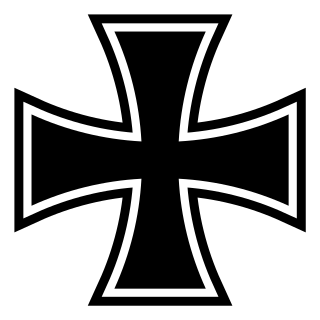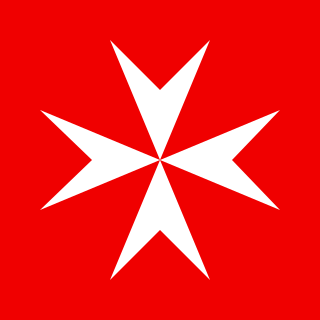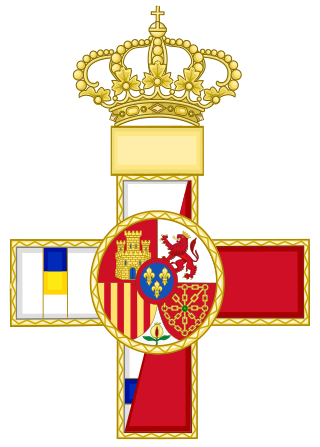
The Iron Cross was a military decoration in the Kingdom of Prussia, and later in the German Empire (1871–1918) and Nazi Germany (1933–1945). The design, a black cross pattée with a white or silver outline, was derived from the insignia of the medieval Teutonic Order and borne by its knights from the 13th century. As well as being a military medal, it has also been used as an emblem by the Prussian Army, the Imperial German Army, and the Reichswehr of the Weimar Republic, while the Balkenkreuz variant was used by the Wehrmacht. The Iron Cross is now the emblem of the Bundeswehr, the modern German armed forces.

A heptagram, septagram, septegram or septogram is a seven-point star drawn with seven straight strokes.

A pentagram is a regular five-pointed star polygon, formed from the diagonal line segments of a convex regular pentagon. Drawing a circle around the five points creates a similar symbol referred to as the pentacle, which is used widely by Wiccans and in paganism, or as a sign of life and connections. The word "pentagram" refers only to the five-pointed star, not the surrounding circle of a pentacle.

The Star of David is a generally recognized symbol of both Jewish identity and Judaism. Its shape is that of a hexagram: the compound of two equilateral triangles.

A hexagram (Greek) or sexagram (Latin) is a six-pointed geometric star figure with the Schläfli symbol {6/2}, 2{3}, or {{3}}. Since there are no true regular continuous hexagrams, the term is instead used to refer to a compound figure of two equilateral triangles. The intersection is a regular hexagon.

In geometry, a star polygon is a type of non-convex polygon. Regular star polygons have been studied in depth; while star polygons in general appear not to have been formally defined, certain notable ones can arise through truncation operations on regular simple and star polygons.

The Most Distinguished Order of Saint Michael and Saint George is a British order of chivalry founded on 28 April 1818 by George, Prince of Wales, while he was acting as prince regent for his father, King George III.

The Maltese cross is a cross symbol, consisting of four "V" or arrowhead shaped concave quadrilaterals converging at a central vertex at right angles, two tips pointing outward symmetrically.

The Seal of Solomon or Ring of Solomon is the legendary signet ring attributed to the Israelite king Solomon in medieval mystical traditions, from which it developed in parallel within Jewish mysticism, Islamic mysticism and Western occultism.
In typography, a star is any of several glyphs with a number of points arrayed within an imaginary circle. A commonly used star symbol is the asterisk.

The Star of Lakshmi is a special octagram, a regular compound polygon, represented by Schläfli symbol {8/2} or 2{4}, made from two congruent squares with the same center at 45° angles, and figures in Hinduism, commonly misattributed to Ashtalakshmi, the eight forms, or "kinds of wealth", of the goddess Lakshmi due to being called so in The Return of the Pink Panther.

In geometry, an octagram is an eight-angled star polygon.
The Order of Leopold II is an order of Belgium and is named in honor of King Leopold II. The decoration was established on 24 August 1900 by Leopold II as Sovereign of the Congo Free State and was in 1908, upon Congo being handed over to Belgium, incorporated into the Belgian awards system. The order is awarded for meritorious service to the sovereign of Belgium, and as a token of his personal goodwill. It can be awarded to both Belgians and foreigners, and is seen as diplomatic gift of merit.
* is an asterisk, a typographical symbol or glyph.

A five-pointed star (☆), geometrically an equilateral concave decagon, is a common ideogram in modern culture. Comparatively rare in classical heraldry, it was notably introduced for the flag of the United States in the Flag Act of 1777 and since has become widely used in flags.
Star polygons and polygonal compounds are the basis for numerous figures of significance in arts and culture. The figure may be the border or interior of the polygon, or one or more closed polygonal paths that include all of the border and also have some legs crossing the interior. The name is derived from the polygon's similarity to the diffraction spikes of astronomical stars, but specific uses may exploit the connection or not. Stars often represent the unity of states within a country when they are used as a part of the flag.

The unicursal hexagram is a hexagram or six-pointed star that can be traced or drawn unicursally, in one continuous line rather than by two overlaid triangles. The hexagram can also be depicted inside a circle with the points touching it. It is often depicted in an interlaced form with the lines of the hexagram passing over and under one another to form a knot. It is a specific instance of the far more general shape discussed in Blaise Pascal's 1639 Hexagrammum Mysticum.

The Cross of Military Merit is Spain's military awards for gallantry or merit in war or peace. Awarded to members of the Spanish Armed Forces, Guardia Civil or civilians.

The Cross of Naval Merit is a Spanish military award for gallantry or merit in war or peace. Awarded to members of the Spanish Naval Forces, Guardia Civil or civilians.